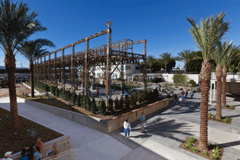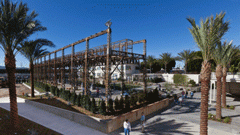Aging industrial site becomes a sustainable green space

City-owned Burbank (Calif.) Water and Power (BWP) has completed the first phase of its plan to transform its main campus from an industrial relic into a regenerative utility campus, called EcoCampus. BWP commissioned Culver City, Calif.-based AHBE Landscape Architects (AHBE) to create the project’s master plan.
The campus contains three of California’s 50 LEED Platinum buildings, including the first LEED Platinum-designed warehouse. The Platinum rating, which is the highest level of certification, provides independent, third-party verification that a building project is environmentally responsible and a healthy place to live and work.
The campus has several sustainable features, including:
Rooftop gardens — The campus administration building has three rooftop gardens that reduce the heat island effect, help channel and filter storm water, and reduce the building’s air conditioning requirements.
Water reclamation and filtration — The campus features five types of water filtration technologies. The project features one of the longest “green streets” in Southern California.
Solar power — An architectural solar array powers the LEED Platinum service center and warehouse building. The array channels rainwater to a filtration system.
Reclaimed substation — The structure of an old electric substation was purposely left intact and repurposed as a trellis. The skeletal remains of the substation soon will be covered in living vines, creating an interesting juxtaposition of industry and environment.
Green space — The project’s landscaping serves a dual purpose. Aesthetically, the landscaping provides green space for employees and the public. Functionally, the landscaping houses water filtration systems.
EcoCampus is the only industrial project out of 150 national and international projects to be included in the Sustainable Sites Initiative (SITES) pilot program.
“BWP has served this community for almost 100 years,” said Ron Davis, BWP general manager. “We owe it to our customers to ensure that we continue to do so, which means we should seek long-term solutions to the problems that our industry faces. Most notably, how do we generate the water and power that our customers need with the least impact on our environment?”
“Landscape has a key role to play in the regeneration of our cities,” said Calvin Abe, president of AHBE. “Beyond the aesthetics, it can proactively counteract many of the problems that we face in urban environments. BWP’s EcoCampus stands as a restorative example of what can be accomplished when there is a long-term vision.”
BWP services 45,000 households and 6,000 businesses in Burbank with water and electricity. The utility conducts other sustainable practices, such as reducing Burbank’s dependence on costly potable water resources by expanding its recycled water system.




















